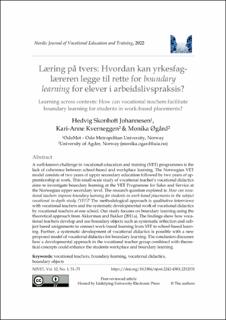| dc.contributor.author | Johannesen, Hedvig Skonhoft | |
| dc.contributor.author | Kverneggen, Kari-Anne Helleberg | |
| dc.contributor.author | Øgård, Monika | |
| dc.date.accessioned | 2022-08-02T13:34:17Z | |
| dc.date.available | 2022-08-02T13:34:17Z | |
| dc.date.created | 2022-04-22T10:02:45Z | |
| dc.date.issued | 2022-02-17 | |
| dc.identifier.citation | Nordic Journal of Vocational Education and Training. 2022, 12 (1), 51-75. | en_US |
| dc.identifier.issn | 2242-458X | |
| dc.identifier.uri | https://hdl.handle.net/11250/3009815 | |
| dc.description.abstract | A well-known challenge in vocational education and training (VET) programmes is the lack of coherence between school-based and workplace learning. The Norwegian VET model consists of two years of upper secondary education followed by two years of apprenticeship at work. This small-scale study of vocational teacher’s vocational didactics aims to investigate boundary learning at the VET Programme for Sales and Service at the Norwegian upper secondary level. The research question explored is: How can vocational teachers improve boundary learning for students in work-based placements in the subject vocational in-depth study (YFF)? The methodological approach is qualitative interviews with vocational teachers and the systematic developmental work of vocational didactics by vocational teachers at one school. Our study focuses on boundary learning using the theoretical approach from Akkerman and Bakker (2011a). The findings show how vocational teachers develop and use boundary objects such as systematic reflection and subject based assignments to connect work-based learning from YFF to school-based learning. Further, a systematic development of vocational didactics is possible with a new proposed model of vocational didactics for boundary learning. The conclusion discusses how a developmental approach in the vocational teacher group combined with theore-tical concepts could enhance the students workplace and boundary learning. | en_US |
| dc.language.iso | mis | en_US |
| dc.publisher | Linköpings University Electronic Press | en_US |
| dc.relation.ispartofseries | Nordic Journal of Vocational Education and Training;Volume 12 Issue 1 (2022) | |
| dc.rights | Navngivelse 4.0 Internasjonal | * |
| dc.rights.uri | http://creativecommons.org/licenses/by/4.0/deed.no | * |
| dc.subject | Vocational teachers | en_US |
| dc.subject | Boundary learning | en_US |
| dc.subject | Vocational didactics | en_US |
| dc.subject | Boundary objects | en_US |
| dc.title | Læring på tvers: Hvordan kan yrkesfaglæreren legge til rette for boundary learning for elever i arbeidslivspraksis? | en_US |
| dc.title.alternative | Learning across contexts: How can vocational teachers facilitate boundary learning for students in work-based placements? | en_US |
| dc.type | Peer reviewed | en_US |
| dc.type | Journal article | en_US |
| dc.description.version | publishedVersion | en_US |
| dc.rights.holder | © The authors | en_US |
| cristin.ispublished | true | |
| cristin.fulltext | original | |
| cristin.qualitycode | 1 | |
| dc.identifier.doi | https://doi.org/10.3384/njvet.2242-458X.2212151 | |
| dc.identifier.cristin | 2018326 | |
| dc.source.journal | Nordic Journal of Vocational Education and Training | en_US |
| dc.source.volume | 12 | en_US |
| dc.source.issue | 1 | en_US |
| dc.source.pagenumber | 51-75 | en_US |

